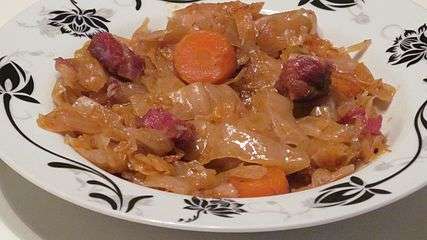Whole sour cabbage
Whole sour cabbage (Croatian: Kiseli kupus u glavicama, literally: "cabbage soured in heads")[1] is a fermented vegetable food preserve, popular in Bosnian, Croatian, Serbian and Bulgarian cuisines. It is similar to sauerkraut (Croatian: Sečeni kiseli kupus, literally "cabbage soured chopped"), with the difference that it is prepared through the lacto-fermentation of whole heads of cabbage, not separate leaves or grated mass. No vinegar or boiling is required.
It is a commonly home made food preserve, and many families have big barrels (20–200 liter) in their cellars or other suitable places that they fill every autumn with cabbages to make this traditional food.
Nutritional qualities are same as those of sauerkraut.
Cabbage
The quality of the cabbage is the main factor in obtaining a good result and the requirements are somewhat higher and more specific in comparasion to sauerkraut. The heads should be nearly round, but, slightly flattened on the top. Since they are processed as whole, it is very important for the pressure to be distributed uniformly on the entire surface. The core should be as small as possible, since too large a core represents a waste and therefore its fermentation rate would differ from the leaves rate (the fermentation must proceed uniformly everywhere). For the same reason, the ribs should not be too expressed; they should be firm, however not too hard and fibrous. The head should be firm and very compact. Its firmness should not be owed to mechanical tissues, but to the compactness – the leaves should be packed very densely. The leaves themselves should be firm, but thick; their palisade mesophyll should be particularly well developed, not the spongy mesophyll or epidermis. The cellulose content should not be high. They should be rich in sugar and dry content. At all levels there should be as little spaces as possible that could trap air. Such physical characteristics would permit the head to ferment and not to disintegrate, on one side, and on another – to stay soft, but crispy, and not to become tough and paper-like, as well as to have a uniform fermentation.
Preparation
After the external leaves and core have been removed, the cabbage heads are salted, packed into the barrel as densely as possible (another reason why round form is required) and covered with salted water (4–6% of salt). A heavy load (a rock, for example) is placed above, to keep them under the water, in anaerobic conditions. From time to time the water has to be reversed (flushed from the bottom of the barrel and than again sluiced onto the top), adding somewhat (but, always with salt) if necessary.[2] A higher salinity makes the fermentation slower, while an insufficient salinity makes it unsafe. Higher temperatures require a higher salinity. The fermentation should be done at 16-22 °C. The best temperature is 18-20 °C. A cabbage fermented at a lower temperature has a better fragrance. The best known microorganisms involved in the process include Leuconostoc mesenteroides, Lactobacterium brevis, Streptococcus faecalis, Pediococcus cerevisiae and Lactobacterium plantarum.[1]
 Pressing salt into cabbage
Pressing salt into cabbage A barrel filled with cabbage heads
A barrel filled with cabbage heads
Use
The sour cabbage is popular Bulgarian, Croatian and Serbian food, consumed mainly during the winter half of the year, both raw or cooked. As raw, it is a very popular winter salad, served usually dusted with pepper powder (aleva paprika) and/or black pepper (but, also just as is). In cooking it is used for sarma in the first place, and for other dishes, such as podvarak.
 Sarma
Sarma Podvarak
Podvarak
See also
References
- 1 2 Šumić, dr Zdravko; Dupalo, Predrag, eds. (10 November 2014). "Tehnologija proizvodnje kiselog kupusa". Tehnologija hrane/Enciklopedija. Tehnologija hrane. Retrieved 1 February 2015.
- ↑ Mihajlović, Ilija, ed. (7 November 2014). "KISELJENJE KUPUSA". AGRO INFO TEL. Agroinfotel. Retrieved 1 February 2015.